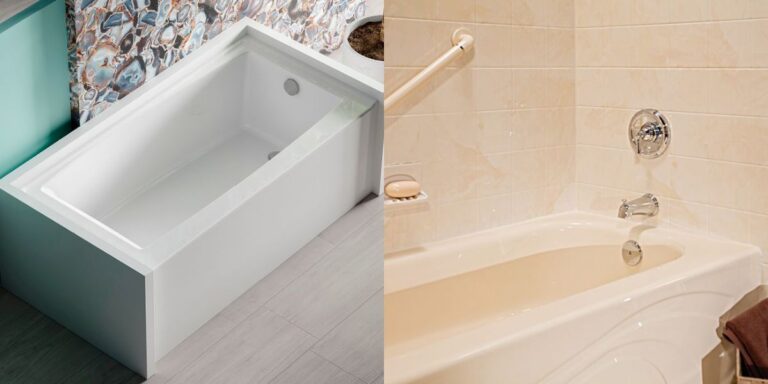Why Do Acrylic Bathtubs Crack? Factors That Lead To Cracking
Without a doubt, the material that seems most prone to cracking is acrylic. Now acrylic tubs were all the rage back in the 70s and 80s. And I’ll admit, they can look pretty sharp when newly installed, with their glossy finish and molded-in soap dishes.
But in my experience, it doesn’t take long before many of those acrylic tubs start showing signs of damage. Cracks tend to appear out of nowhere – one day you’re taking a relaxing bath, the next your tub looks like a spiderweb!
So what causes these annoying and unsightly cracks in acrylic tubs?
And what can you do to avoid or repair them? I’ve fixed enough busted acrylic over the years to learn the main reasons acrylic bathtubs crack. Here’s my insider perspective on why acrylic tubs develop cracks and how to keep your tub in tip-top shape.
What Causes Cracks in Acrylic Tubs?
When an acrylic tub cracks, it’s usually caused by one of these common issues:

Improper Installation
One of the biggest reasons acrylic tubs crack is improper installation. If the tub isn’t adequately supported underneath or fully level, it’s prone to flexing, shifting, and eventually cracking under weight.
The tub surround and base have to be sturdy enough to bear the weight of a tub filled with water and a person – up to hundreds of pounds! Rushing through the installation or taking shortcuts leads to cracks down the road.
Using Harsh Cleaners and Abrasives
While acrylic has a shiny appearance, it’s easily scratched and damaged by harsh chemicals and abrasive pads or brushes. Yet many homeowners, wanting that “squeaky clean” feel, regularly scrub their tubs with heavy-duty cleaners and scouring pads.
Over time, all that harsh scrubbing creates tiny scratches and cracks in the surface. A much better bet is using gentle liquid cleaners and soft rags or sponges. Treat acrylic tubs with care!
Extreme Temperature Changes
Exposing an acrylic tub to extreme hot and cold temps can also cause cracking. The rapid expansion and contraction of the tub places stress on the acrylic. So if you’re someone who enjoys following up a steamy bath with an ice-cold shower, you may be putting your tub at risk! Also, poorly insulated tub surrounds that get cold in winter can create temperature shock.
Structural Issues and Weight
Cracks often appear near the tub bottom because that area supports the most weight. If the floor joists sag or weaken over the years, the stress can lead to cracks. The tub itself can also warp or bend from regular use, resulting in cracks along the bottom. Meanwhile, if the home’s foundation shifts significantly, it can bend or twist the whole tub out of shape.
Common Locations for Cracks
Based on the typical causes, acrylic tub cracks tend to appear in some predictable places:
Along the Bottom
Like I mentioned, cracks along the bottom of the tub are very common due to the weight and pressure focused there. They usually start small and branch out in spiderweb patterns.
Around the Drain
The drain assembly is inserted through a hole cut in the tub, creating an area of weakness. Cracks often emanate from this vulnerable point, caused by shifting, flexing, or repeated contact with rough cleaning tools.
Near Chip or Scratch Damage
Chips and scratches anywhere on the tub can eventually turn into larger cracks. Even minor damage to the surface makes it weaker and more prone to cracking over time.
Here Are Three Factors That Lead to Cracking
If you’re wondering why acrylic tubs seem so much more inclined to crack compared to other tub materials, here are some likely factors:
Low-Quality Materials
Cheaper acrylic tubs may use subpar acrylic that’s thinner and less flexible. Thicker, high-quality acrylic is more durable and crack-resistant. However many manufacturers cut corners to save on costs.
Poor Manufacturing
Shoddy construction like weak seams, poor bonding of layers, and casting flaws can make cracks more likely even in new tubs. Reputable brands tend to have better quality control.
Mishandling During Shipping or Installation
Cracks can begin forming if a tub is roughly handled in shipping or during installation. Dropping it or banging it around puts immediate stress on the acrylic. Careful handling prevents damage.
What Are the Signs Your Tub May Crack?
To help prevent cracking issues, keep an eye out for these early warning signs:
Visible Chips, Scratches, or Gouges
Any visible surface damage is a red flag, especially near the drain or along the bottom. Use a repair kit immediately to prevent further cracking.
Discoloration or Hazing
If parts of your tub lose their glossy sheen and start looking dull or cloudy, it indicates microscopic scratching that weakens the acrylic.
Slow Draining
A slow drain could mean sagging, slanting, or distortion of the tub from shifting or too much weight. This puts extra stress on the acrylic.
How To Prevent Cracks in Acrylic Tubs?
The best defense against acrylic tub cracks is prevention. Here are some tips to minimize damage:
Proper Leveling and Support
Having the tub professionally installed and leveled on a well-built platform prevents flexing and distortion.
Avoiding Forceful Impacts
Handle your tub gently, and avoid hard blows from falling bottles, toys etc. which can chip or crack it.
Using Non-Abrasive Cleaners
Clean gently with liquid detergent, water, and soft rags or sponges. Avoid scratching the surface.
Maintaining Proper Water Levels
Don’t overfill the tub and cause overflow. The weight can lead to cracks along the bottom.
Inspecting for Early Signs of Damage
Periodically check for scratches, dull spots, pooling water, and slow drainage which indicate problems ahead. Address any issues quickly.
Repairing Small Cracks
If detected early, small cracks and chips in acrylic tubs can often be repaired:
Using Acrylic Patch Kits
DIY acrylic repair kits are readily available. Just thoroughly clean the area, apply adhesive, and “weld” the patch in place. Wet sanding blends the edges. Kits with colored acrylic sheets match most tub finishes. Follow directions closely for best results.
Conclusion:
In summary, acrylic bathtubs are prone to cracking over time due to their inherent flexibility and soft surface. Improper support, harsh cleaning, and excessive weight are common culprits. But some preventative care and prompt repairs can maximize the life of your acrylic tub.
And if it eventually loses the battle with cracks, replacement options abound. With my years in the plumbing trenches, I’ve got plenty of experience helping homeowners keep their tubs in tip-top, crack-free condition. Let me know if you need any acrylic tub troubleshooting – I’m happy to help!
- How Long Do Acrylic Tubs Last? How to Extend The Lifespan?
- Do Acrylic Tubs Feel Cheap? Factors Discussed
- What Cleaners Are Safe for Acrylic Tubs?
- What Not To Use On Acrylic Tubs? 5 Things To Avoid

William J. Bullock is a licensed plumber with over 15 years of experience installing and repairing bathtubs. He runs his own plumbing company in Greenville and serves residential and commercial clients. William is dedicated to providing honest, transparent advice to help homeowners make informed decisions about their bathroom renovations.
He has established expertise in selecting bathtubs, planning custom installations, diagnosing issues, and completing repairs. William aims to share practical tips and reliable recommendations based on extensive hands-on work. When he isn’t on a job site, William enjoys spending time with his family and volunteering at local community events. He takes pride in delivering quality service and enjoys helping people upgrade their homes.







